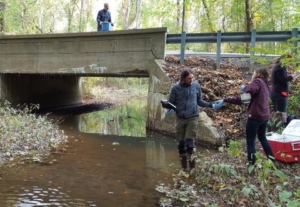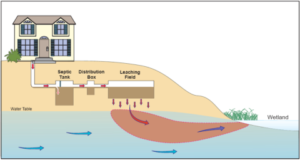An environmental chemist at the University of Maryland Center for Environmental Science Chesapeake Biological Laboratory is using an artificial sweetener to track pollution in local streams.

Michael Gonsior testing one of the streams. Photo by Mindy Forsyth
Michael Gonsior is developing chemical tracers “to identify the presence of septic wastewater in streams” and linking that to nutrient loading in the southern part of the state. Pollutants from septic systems, including nitrogen and chemicals from beauty and cleaning products, end up in groundwater and then in streams. Older septic systems are much less likely to catch these pollutants.
His team collected water samples monthly from 9 sites in Calvert County. To analyze which streams were impacted by septic systems, his team chose to follow sucralose – better known as Splenda – to figure out where septic system water was going. Sucralose doesn’t degrade and would not naturally be found in the stream, so if you know how much is in the septic tank, and you sample how much is in a stream, you can calculate how much of the stream water comes from septic systems.

This diagram shows how wastewater from a home can leach into nearby waterways.
Gonsior’s team found high concentrations of sucralose in some of the streams, showing that there is an impact of septic systems on these streams. He adds, “This data correlates quite well with the nitrogen loading, so we have indirect correlation that the nitrogen we see is likely to be coming from the septic systems.”
Due to these contaminants, there are likely no fish present In the streams, and these pollutants have an impact for Chesapeake Bay. Gonsior’s research is some of the first to evaluate the “connectivity between septic systems and the stream network.” The team will continue to analyze how much nitrogen is coming from septic tanks.
Originally reported by UMCES’ “Science in the First Person“
